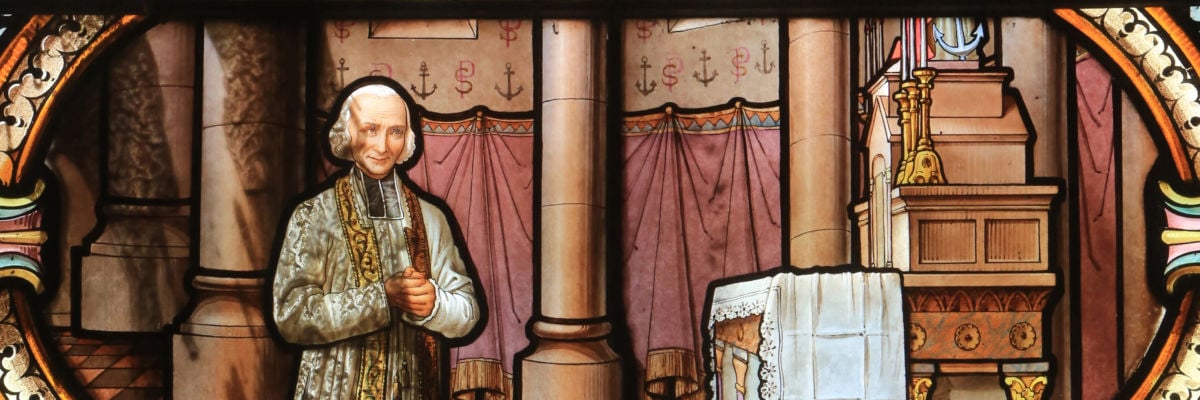
Ours is an age of pastoral crisis, of shepherd-less flocks—or, worse, flocks infiltrated by wolves in shepherds’ clothing. But hope has the most space to spring eternal when matters are hopeless. And when it comes to the collapse in confidence regarding the priesthood, which is rampant in these dark days of betrayal and dwindling vocations, St. John Marie Baptiste Vianney is the heavenly priest and patron to turn to.
John Marie Vianney was born in May on his father’s family farm in the village of Dardilly, France, 1786—in a time of wild terror, as the Revolution surged out of Paris with the Bastille laid low and La Guillotine raised high. The Civil Constitution of the Clergy was in force, resulting in the Reign of Terror that ravaged France with fire. The blades chopped endlessly on their blocks, their pulleys screaming for the head of every Catholic priest as churches were chained, bells hung silently, and crossroad shrines lay broken. The way to heaven seemed suddenly lost.
But in the midst of this madness, a lad named John faithfully herded sheep—a beautiful precursor for his ultimate vocation. He tended his father’s livestock, telling his beads surreptitiously in his pocket, as he had been taught, and had made a secret shrine to his virgin namesake in a willow tree over by the stream. There John would act out Mass with other village children, and the God-hating world was never the wiser.
John was already called the Curé by his playmates, and his play was practice for serious work to come. For if anything was needed in those days of persecution, it was priests. And the Vianneys knew it. Rumor had it that many a priest on the run was hidden and helped at Matthieu Vianney’s farm. Murmurs said Mass was secretly celebrated in his home by hunted holy men. Through it all, the boy learned the fear and the faith of the catacombs, and he instinctively longed to enter into this life he regarded as the life of a hero.
When John was sixteen, the bells of Notre Dame de Paris rang in Easter morning with the liberation of Catholic France by Napoleon Bonaparte (who would go on to wage his own war against the Church, but that is another story). It was then that Fr. Balley arrived as pastor, and John, intelligent but ignorant, began to study under him as he discerned a vocation to the priesthood. Though he struggled, especially in Latin, the patience and perseverance of both pupil and pastor paid off, and John Marie made progress slowly and steadily.
But nothing worth obtaining is easily obtained. As John labored toward the priesthood, Napoleon made war with Spain, and John was enlisted. The physical mortifications he had adopted by the example of the saintly Fr. Balley, which would make him so strong as a priest, made him too weak to be a soldier. Though he dutifully attempted to catch up with his company, he fell in with straggling deserters and was forced into hiding until the occasion of the emperor’s marriage prompted a general pardon, allowing John to return to his holy studies. He was ordained to the priesthood at twenty-nine years of age.
After assisting Fr. Balley until that priest’s passing, Fr. Vianney was sent to a small, plain parish in the small, plain village of Ars. It was only twenty miles from his birthplace, but so obscure that the Curé couldn’t find it. Ironically, he became lost as his first act as a pastor, unable to find his flock altogether. Running across a group of young shepherds in the fog that rolled from a swamp, Fr. Vianney called out, “Can you tell me the way to Ars?” Fluent only in their patois, the children did not respond. “Ars? Ars?” repeated the priest. A boy understood and pointed.
“You have shown me the way to Ars,” the Curé said. “I shall show you the way to heaven.”
He finally strode into Ars with its fifty or so drab clay houses huddled in the flats—stagnant ponds, barren soil, brambly thickets, a walnut orchard, a lonely chateau with tower, moat, and battlement, a cemetery, a rectory, and the broken-down church of St. Sixtus. The Curé rejoiced and set himself up for his life’s work in the shabby church and with austerity in the shabby rectory.
There is an excellent and extraordinary reason why John Marie Vianney is remembered as the Curé, or parish priest. He was a priest before all else, and Ars awoke with the vigor of his priesthood. While he lived simply, eating potatoes and drinking water, he served tirelessly, doing penance, preaching sermons, hearing confessions, interfering at uncouth public events, and turning every ounce of his mortal being and immortal spirit to the bodies and souls of his town.
The Curé lifted the poor from the dust with gentle compassion and brought the Word of God to his people with zeal. While he may have preached fire and brimstone from his pulpit, there was nothing but love and mercy pouring from his confessional. Despite the devil’s nightly raids to the rickety rectory, shaking it to its foundation to keep the holy priest from his brief rest, the Curé remained strong and even glad to know that his work was making the evil one angry.
He paid the fiddler double his fee to stay home instead of playing for riotous street dances. He rebuked the girl who merely watched these dances, saying “she danced in her heart if not with her feet.” He reproached the innkeeper who served wine to family men who should have been feeding their families with the money they paid for drink. He forced public houses out of business. He refused absolution with an uncanny scent for duplicity. At the same time, and more importantly, he ignited a desire for virtue. He inspired rest on Sunday. He introduced innocence in rest. John Marie Vianney was a true apostle—a priest and a pastor who brought the life of God to those who had forgotten him.
The Curé of Ars passed away after three days of agony in a heat wave on August 4, 1859. The men of Ars flung sheets soaked with water across the roof to cool his room against the sun, dousing them to the day he died while his loyal flock mourned him in the courtyard below. But the pastor was called again, and this time to the arms of the Good Shepherd himself. The peace that settled into his countenance can be seen today on the death mask that adorns the saint’s miraculously incorrupt body in the basilica that now abuts his little church of St. Sixtus in Ars. As it was even in his lifetime, Ars remains a place of constant pilgrimage, for when a priest tends to his flock as he is ordered to, it attracts those who have gone astray and lost hope.
The situation for Catholics today may well be regarded as something approaching hopelessness. The tailspin of ex-cardinal Theodore McCarrick, the exposé of the USCCB’s Msgr. Jeffrey Burrill, and more paint a grim picture. It is at times such as these that Catholics must put their eggs in the baskets of those who cannot fail us.
The wayward world needs to discover once again the life-giving power of the priesthood. That can happen through the prayers of the Curé of Ars, who has not ceased to care and intercede for his brothers and sisters in Christ and to continue leading the way to heaven. St. John Marie Vianney, pray for us and for all priests!



